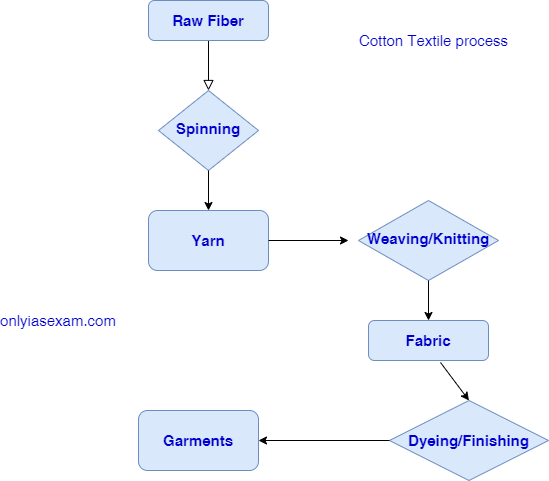Table of Content:
- A positive role in the Indian Economy
- Historical Background
- Locational Factors of the Cotton Industry
- Major Locations
- Process Involved
- Major Subsector
- Current Challenges
The cotton textile industry has a unique position in the Indian Economy as it has the following positive roles:
- It is a self-reliant and well-established completer value chain from raw material to finished goods.
- It provides major employment
- Major Foreign Exchange earner
Historical Background:
- Up to the 18th century, cotton textile was produced by Handloom and Hand spinning weaving technology
- After the 18th Century, the power loom came.
- During the Britisher period, traditional industries suffered most because of Britisher's policy and import of mill-made cloth from England.
- The first Textile mill was established in 1854 in Mumbai.
- In the 20th century, because of the two world wars fought in Europe, the demand for clothing increased, and a major boost can be seen in India.
Locational Factors of Cotton Industry:
The following are the favorable location factors of the cotton industry:
- Availability of Raw Cotton
- Market
- Transport facilities
- Accessibility of Port
- Labour
- Moist Climate
- Skilled and semi-skilled labor
Initially, cotton industries were developed in Maharashtra and Gujarat due to the availability of a moist humid climate. But nowadays, the moist climate can be generated in an artificial way. The cotton industry is not weighted losing raw material hence cotton industries are seen in the other part of India also. At present. the High concentration of the cotton textile industry belt is seen in Maharastra, Gujarat, and Tamil Nadu because of the above favorable factors.
The following are the major locations of cotton textile industries in India:
Maharastra:
- Mumbai
- Pune
- Aurangabad
- Jalgaon
- Wardha
Gujarat:
- Surat
- Vadodara
- Ahmedabad
- Rajkot
- Porbandar
Ahmedabad is also called Manchester of India as it is the most suitable location for cotton industries Such as:
- Very close to raw cotton
- Flatland
- Humid climate
- Skilled and semi-skilled labor is easily available
- Well developed railways and roadways network
- Near port
Tamil Nadu:
- Chennai
- Coimbatore
- Madurai
West Bengal:
- Murshidabad
- Haora
- Hugli
Uttar Pradesh:
- Moradabad
- Agra
- Kanpur
The following process and value addition are involved in the production of raw cotton to cloth.
After Independence, the Cotton Industry gradually recovered and flourished. Production of cloth increases almost 5 times over 50 years. Along with cotton industries, other supporting industries such as chemical, dye, packing materials, and engineering work industries also developed.
The cotton textile industry can be divided into three sub-sectors:
- Handloom
- Powerloom
- Mill station
Handloom:
- It is labor-intensive and provided employment to semi-skilled workers.
- Need small capital
- The process involves Spinning, weaving, and finishing fabrics.
Powerloom:
- Introduced machine and require less labor
- The volume of production increases
Mill Sectors:
- Highly capital Intensive and produce fine quality of cloth.
Current challenges:
- We have world-class production of spinning but have a high quality fabric production
- The power supply is erratic
- Machinery needs to be upgraded
- Low output to labor ratio
- Stiff competition with synthetic fiber
Export:
We export yarn to many countries:
- Japan
- the USA
- UK
- Russia
- Europe
- Nepal
- Sri Lanka
- Analyze the location, distributional pattern, and problems of cotton textile industries in India. (UPSC, 2016. 250 words, 20 marks)
- Discuss the factors governing the location of agro-based industries in India. ( 64th BPSC 2019)
- Describe the problems of agro-based industries in India in general and cotton textiles in particular. (UPSC 2014, 200 words, 15 marks)
- Discuss the factors governing the location of agro-based industries in India
- Locational factors of the cotton Industry
- Agro-based industries
- Evolution of industries
- Classification of Industries
- Factors affecting the location of Industries
- Locational factors of cotton Industry | Cotton Industry in India
- Locational factors of Jute Industry | Jute Industry in India
- Iron and Steel Industry| Evolution of Iron and Steel Industry
- Aluminium Industry
- Fertilizer Industry
- Paper Industry
- Chemical Industry
- Petrochemical Industry
- Pharmaceutical industry
- Automobile industry
- Cottage industry
- Agro-based industries
- Industrial houses and complexes including public sector undertakings
- Industrial regionalization
- New industrial policies
- Multinationals and liberalization
- Special Economic Zones
- Tourism including eco-tourism
- Petro-Chemical Industrial in India
- Status of different types of tourism in India

1 Comments:
Click here for CommentsReally this post is positive. You have successfully placed your detailed idea about the fact of " location is the fact for cotton production".
ConversionConversion EmoticonEmoticon